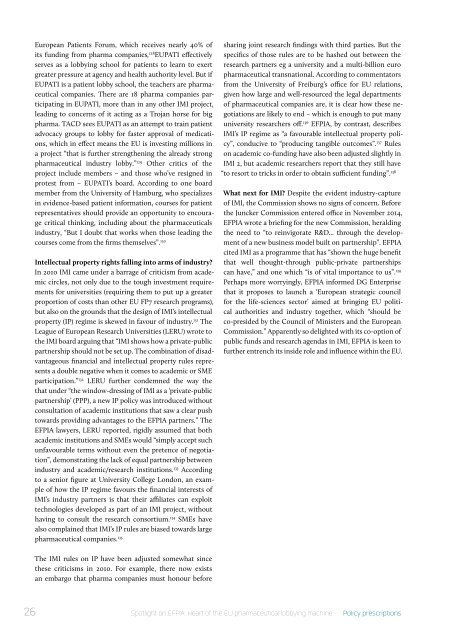Policy prescriptions
20150827_bigpharma_web
20150827_bigpharma_web
- No tags were found...
Create successful ePaper yourself
Turn your PDF publications into a flip-book with our unique Google optimized e-Paper software.
European Patients Forum, which receives nearly 40% of<br />
its funding from pharma companies, 128 EUPATI effectively<br />
serves as a lobbying school for patients to learn to exert<br />
greater pressure at agency and health authority level. But if<br />
EUPATI is a patient lobby school, the teachers are pharmaceutical<br />
companies. There are 18 pharma companies participating<br />
in EUPATI, more than in any other IMI project,<br />
leading to concerns of it acting as a Trojan horse for big<br />
pharma. TACD sees EUPATI as an attempt to train patient<br />
advocacy groups to lobby for faster approval of medications,<br />
which in effect means the EU is investing millions in<br />
a project “that is further strengthening the already strong<br />
pharmaceutical industry lobby.” 129 Other critics of the<br />
project include members – and those who’ve resigned in<br />
protest from – EUPATI’s board. According to one board<br />
member from the University of Hamburg, who specializes<br />
in evidence-based patient information, courses for patient<br />
representatives should provide an opportunity to encourage<br />
critical thinking, including about the pharmaceuticals<br />
industry, “But I doubt that works when those leading the<br />
courses come from the firms themselves”. 130<br />
Intellectual property rights falling into arms of industry?<br />
In 2010 IMI came under a barrage of criticism from academic<br />
circles, not only due to the tough investment requirements<br />
for universities (requiring them to put up a greater<br />
proportion of costs than other EU FP7 research programs),<br />
but also on the grounds that the design of IMI’s intellectual<br />
property (IP) regime is skewed in favour of industry. 131 The<br />
League of European Research Universities (LERU) wrote to<br />
the IMI board arguing that “IMI shows how a private-public<br />
partnership should not be set up. The combination of disadvantageous<br />
financial and intellectual property rules represents<br />
a double negative when it comes to academic or SME<br />
participation.” 132 LERU further condemned the way the<br />
that under “the window-dressing of IMI as a ‘private-public<br />
partnership’ (PPP), a new IP policy was introduced without<br />
consultation of academic institutions that saw a clear push<br />
towards providing advantages to the EFPIA partners.” The<br />
EFPIA lawyers, LERU reported, rigidly assumed that both<br />
academic institutions and SMEs would “simply accept such<br />
unfavourable terms without even the pretence of negotiation”,<br />
demonstrating the lack of equal partnership between<br />
industry and academic/research institutions. 133 According<br />
to a senior figure at University College London, an example<br />
of how the IP regime favours the financial interests of<br />
IMI’s industry partners is that their affiliates can exploit<br />
technologies developed as part of an IMI project, without<br />
having to consult the research consortium. 134 SMEs have<br />
also complained that IMI’s IP rules are biased towards large<br />
pharmaceutical companies. 135<br />
sharing joint research findings with third parties. But the<br />
specifics of those rules are to be hashed out between the<br />
research partners eg a university and a multi-billion euro<br />
pharmaceutical transnational. According to commentators<br />
from the University of Freiburg’s office for EU relations,<br />
given how large and well-resourced the legal departments<br />
of pharmaceutical companies are, it is clear how these negotiations<br />
are likely to end – which is enough to put many<br />
university researchers off. 136 EFPIA, by contrast, describes<br />
IMI’s IP regime as “a favourable intellectual property policy”,<br />
conducive to “producing tangible outcomes”. 137 Rules<br />
on academic co-funding have also been adjusted slightly in<br />
IMI 2, but academic researchers report that they still have<br />
“to resort to tricks in order to obtain sufficient funding”. 138<br />
What next for IMI? Despite the evident industry-capture<br />
of IMI, the Commission shows no signs of concern. Before<br />
the Juncker Commission entered office in November 2014,<br />
EFPIA wrote a briefing for the new Commission, heralding<br />
the need to “to reinvigorate R&D... through the development<br />
of a new business model built on partnership”. EFPIA<br />
cited IMI as a programme that has “shown the huge benefit<br />
that well thought-through public-private partnerships<br />
can have,” and one which “is of vital importance to us”. 139<br />
Perhaps more worryingly, EFPIA informed DG Enterprise<br />
that it proposes to launch a ‘European strategic council<br />
for the life-sciences sector’ aimed at bringing EU political<br />
authorities and industry together, which “should be<br />
co-presided by the Council of Ministers and the European<br />
Commission.” Apparently so delighted with its co-option of<br />
public funds and research agendas in IMI, EFPIA is keen to<br />
further entrench its inside role and influence within the EU.<br />
The IMI rules on IP have been adjusted somewhat since<br />
these criticisms in 2010. For example, there now exists<br />
an embargo that pharma companies must honour before<br />
26 Spotlight on EFPIA: Heart of the EU pharmaceutical lobbying machine <strong>Policy</strong> <strong>prescriptions</strong>


